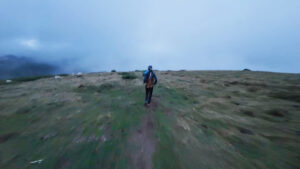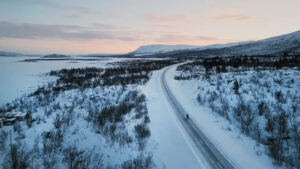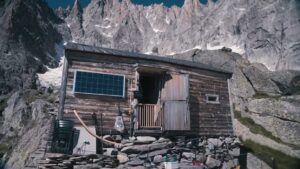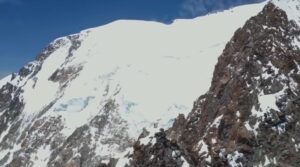How do Native Americans reclaim the identity that was taken from them? How can they connect to their Indigenous traditions when they live in urban environments, removed from the lands that defined their culture for thousands of years?
For one Lakota man from Rapid City, South Dakota, it starts with a buffalo hunt.
That’s the premise of this spellbinding documentary from Patagonia, which combines live music, narration, and animation to tell the story of Christopher White Eagle and the hunt he organized to connect local Indigenous children with their heritage.
There’s no footage of the hunt, here. It happened away from the cameras of Patagonia’s top-notch film crew.

Nick Martin narrates the animated story of an Indigenous buffalo hunt in South Dakota. Photo: Screenshot
Instead, Patagonia organized a live event, complete with a musical trio and Indigenous narrator to present an animated video of the story. It’s a unique and potent approach that shares Native American voices and perspectives — without treading on their privacy or agency.
“For native people growing up in urban or suburban environments, it’s been difficult, sometimes illegal, to maintain our language and culture from before European colonization. Many communities are left feeling…in-between,” says Nick Martin, narrator for the live event and this short video stemming from it. “We’re still tribal citizens, still proudly Indigenous. But our spiritual and emotional pillars have been targeted and eroded by demands for assimilation.”
Martin’s commentary provides context for the larger story of the hunt. Seeking to do something for his community, Cheyenne River Sioux member Christopher White Eagle recruited local native kids to participate in a traditional buffalo hunt on the plains of South Dakota.
He obtained permission slips for 46 kids, both boys and girls ranging from 11 to 17 years old. Then he found 18 adult volunteers to serve as chauffeurs, and a hunting team to take down the aging buffalo, which he identified through his job as a butcher.
“He thought it might help them connect with their traditions and ancestors, but he never imagined how it’d build new hope for the future,” Patagonia wrote in the vid description.
Throughout the hunt, the children experience Lakota traditions of singing and prayer, paying homage to the buffalo that nourish them and the spirits who provide that sustenance.

An image of Christopher White Eagle and a Plains buffalo. Photo: Screenshot
Once the hunting team takes down a buffalo, some of the boys even found the courage to take a bite of the heart, just like their ancestors did for thousands of years. Ultimately, White Eagle butchers the bison, taking home 450 pounds of meat to make soup for his community.
“I sliced them up and that’s how we made our soup,” he said. “This was gonna feed a lot of people. And if you want to feed a lot of people, you go with soup.”
For many of the children, it was the first time they’d tasted bison.
“Like the hunt, the soup was the beginning of a relationship renewed,” Martin says in the narration. “One that could last through whatever South Dakota or America still has in store.”






